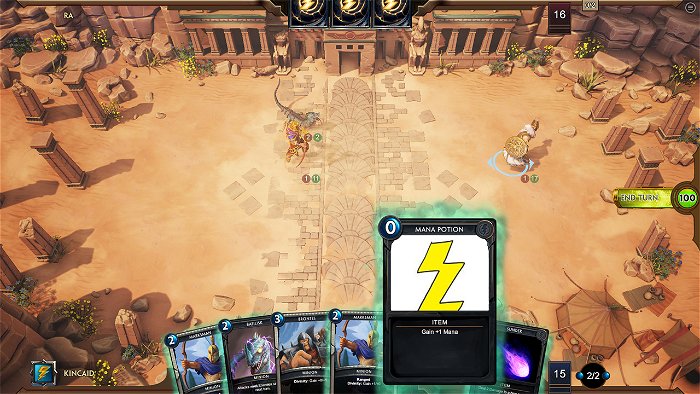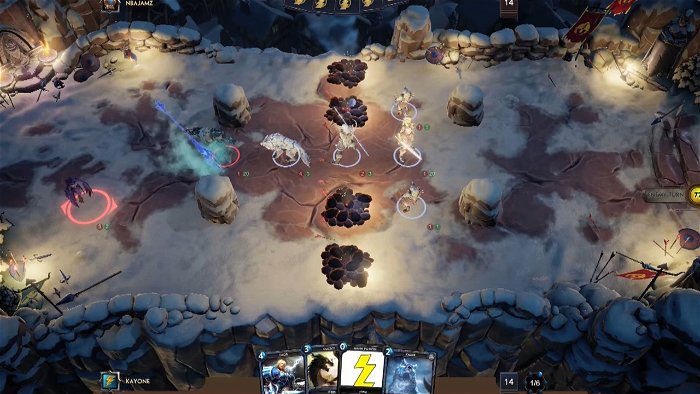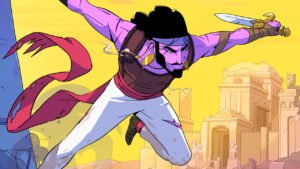It is a universal truth that any game, of any genre, can be improved by the addition of a card battle system—and hey, maybe a tactical grid for good measure. The savvy folks at Hi-Rez Studios know this full well, making Smite Tactics which adds both afformentioned improvements to this slower-paced spin-off of their godly MOBA franchise.
Anyone who has tried the free-to-play game Duelyst will find the formula instantly recognizable. When building a deck, players choose one of three pantheons—Greek, Egyptian or Norse—and select a leader from that faction, such as Zeus, Ra or Freya. Each has a unique ability and acts as your avatar. You assemble a deck containing minions (creatures with passive abilities), gods (creatures with activated abilities) and items (which have a one-use effect). Players take turns drawing cards, summoning creatures and moving those creatures around a flat 5×9 grid in order to outmaneuver, overwhelm and destroy the enemy leader. Cards can be found in packs, purchasable with in-game gold or real money, or crafted using the “canopic dust” earned by disintegrating unwanted cards.
A humble birth

Smite Tactics remains in active development, but you can buy your way into the closed beta (and get a bunch of extra cards) with the purchase of a Founders Pack for $15 USD. However, unless you enjoy watching the messy process of game creation in action, it’s not worth it yet. This is far from the incomplete but shippable product that, for example, Darkest Dungeon was when it entered early access. That much will be obvious with your first glimpse of the often-hilarious temporary art assets. The voice clips stumble over one another, the user interface varies from polished to MS Paint quality, and there’s no tooltip to explain the various abilities. (Only through experience will you learn that “Pardon” means enemies won’t counterattack, or that “Divinity” bonuses trigger when you summon a god.) Of course these issues will be corrected before full release, but they’re worth mentioning when players are invited to pay to experience them.
The gameplay itself is serviceable but unexciting. There’s nothing new, mechanically, and while the components all work together they don’t combine to form a heavenly experience. The emphasis on simplicity will certainly appeal to many, as the intersection of deck building, resource management and tactical positioning already allows for plenty of creative decision making. Gods have one, sometimes two abilities. A few terrain effects (damaging fire, impassable boulders) help promote different strategies, but it’s nothing so complex as the jagged landscapes of a game like Chaos Reborn.
Schism in form and function
However, simplicity needs to be paired with depth, and Smite Tactics isn’t there yet. The card pool is currently very small and puts a limit on the number of strategies you can employ. As a result, the pantheons don’t feel that distinct. Greek cards seem to favour defence and long-term advantage and Norse cards enable aggressive swarms, but Egyptian cards lack any obvious, coherent identity. An Egyptian deck can draw cards, heal units, sacrifice its own units for benefit, directly damage units, return dead creatures, take control of enemy units or buff its units stats. The mechanics are all over the place but only on one or two cards each, so players cannot craft a deck focused on any theme or strategy. Hopefully the problem will be ameliorated as Hi-Rez adds more content, but it does suggest a worrying lack of vision.
If anything it will be the divine flavour that attracts people to Smite Tactics. The various gods are just as fun and well-designed as they are in vanilla Smite, and the character models are exquisitely and almost unnecessarily detailed given how small they are on the game board. Hi-Rez has confirmed that it has frugally borrowed character assets from the MOBA but has added new animations. Those new animations, however, need to be punched up. Never have the righteous thunderbolts of Zeus looked so limp as they do in Smite Tactics, landing with a pop, fizzle and plunk.
Delay for judgment day

There are a number of other problems that combine to make the game feel lifeless and frustrating at times. Much of the card art that isn’t labeled “temporary” remains substandard for a studio of this pedigree, and will hopefully be replaced. The artificial intelligence is dumber than an intoxicated Bacchus, frequently using ranged attacks point-blank, while standing in fire, even when the counterattack will instantly kill them. You can’t see a character’s attack range before committing to movement. Cards with area-of-effect abilities lack essential information; Anubis, for instance, reads “Deals 3 damage in target area.” (What size area? What shape? What range?) There isn’t even a way to see cards that have been played or destroyed.
None of this is to say that Smite Tactics cannot become a polished, engaging product in the future. The base mechanics are all perfectly sound and provide a solid foundation that could be built on for many years. Hi-Rez is known and lauded for supporting and improving its games over time. However, the studio has not put its best foot forward by inviting players in at this stage of development. It’s unclear whether the funds and feedback will be worth a bad first impression. Fans of Hi-Rez needn’t give up faith, but they are better off waiting and praying for the second coming that is launch day.




